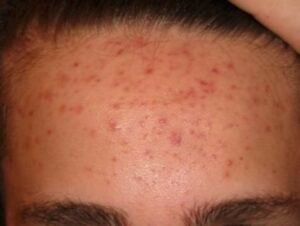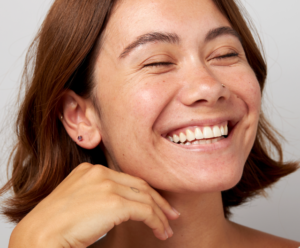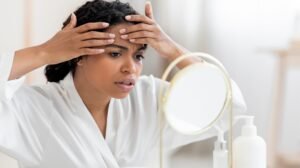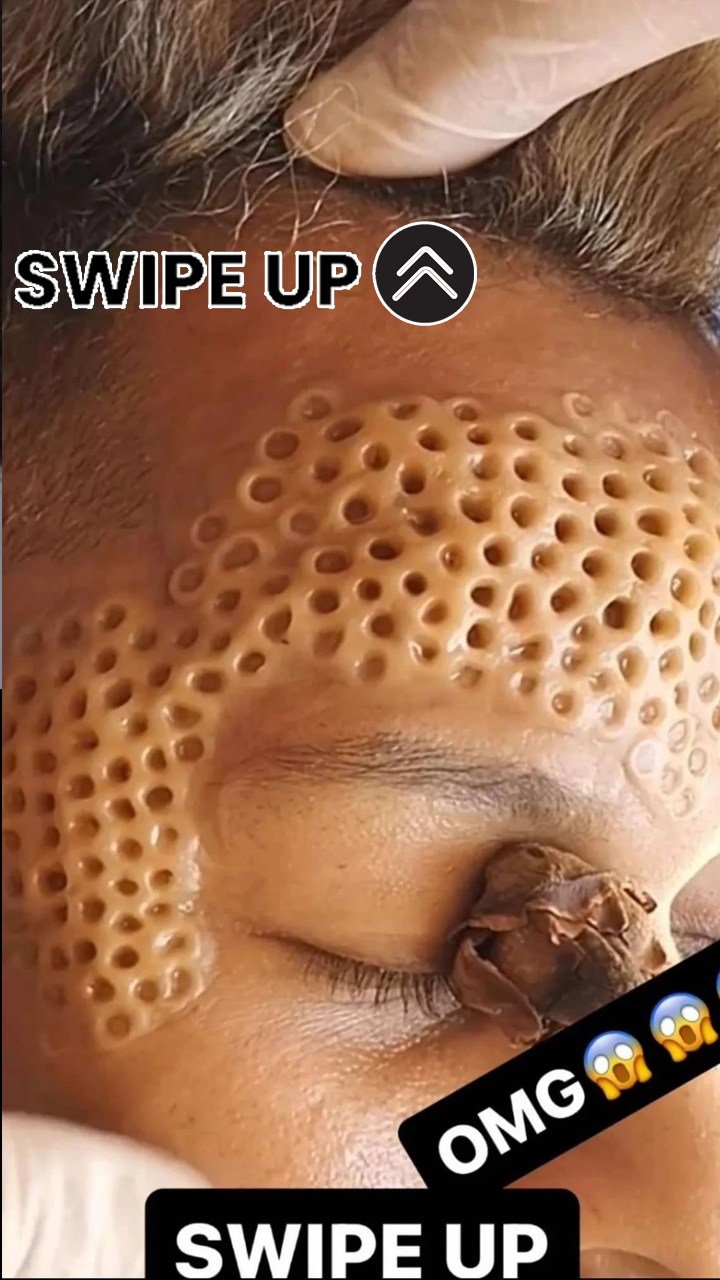
Forehead acne and pimples occur when tiny glands beneath the skin’s surface become clogged, leading to breakouts. Factors such as hormonal changes, stress, and medications can contribute to these breakouts. While acne doesn’t pose significant health risks, it can affect self-esteem and cause discomfort.
In this article, we explore the causes of forehead acne, how to treat it, and ways to prevent future outbreaks.
What is Acne?
Acne is a chronic skin condition that can result in different types of lesions, including:
- Whiteheads
- Blackheads
- Pimples
- Cysts
- Nodules
- Pustules
- Papules: Hard, small bumps on the skin that may cause redness.
Acne can develop anywhere on the body but is most commonly seen on the face, shoulders, back, and chest. It happens when the sebaceous glands, which produce an oily substance called sebum, become blocked by excess sebum, dead skin cells, or bacteria. This leads to inflammation and the formation of pimples.

Causes of Forehead Acne
Several factors can increase the production of sebum, heightening the risk of acne. These include:
- Family History: A genetic predisposition may increase acne likelihood.
- Hormonal Changes: Fluctuations during puberty are a common cause of acne.
- Medications: Some medications, like corticosteroids and hormonal contraceptives, can cause acne as a side effect.
- Stress: Although the link isn’t fully understood, stress is known to trigger acne flare-ups.
- Hygiene: Harsh scrubbing or picking at acne can worsen the condition.
- Hair Products: Certain gels, oils, or waxes can clog pores and cause acne.
- Skin Irritation: Makeup or tight hats can irritate the skin, contributing to breakouts.
- Diet: Some foods might aggravate acne, but research is still ongoing.
- Environmental Factors: Humidity and pollution can worsen acne.

Treatment for Forehead Acne
Over-the-Counter (OTC) Treatments:
Mild to moderate acne can often be treated with OTC products containing ingredients like:
- Benzoyl Peroxide
- Salicylic Acid
- Retinol
- Sulfur
Results may take several weeks, and mild side effects like skin irritation are common. Individuals with sensitive skin may prefer creams or lotions.
Prescription Medications:
For severe cases, a doctor might prescribe:
- Corticosteroids
- Antibiotics
- Retinoids
- Combined Contraceptives
It’s essential to avoid popping pimples to prevent scarring. Treatments for stubborn acne and scarring include:
- Chemical Peels
- Corticosteroid Injections
- Laser and Light Therapies

Home Remedies for Forehead Acne
Alongside medication, home remedies can be effective for mild acne cases. Examples include:
- Warm Compresses: Helps remove excess sebum and speed recovery.
- Aloe Vera: Apply pure aloe vera directly to the skin.
- Tea Tree Oil: Dilute with water and apply with a cotton pad.
- Apple Cider Vinegar: Mix with water and apply to the skin.
- Zinc Supplements: May help improve skin health.
For an overnight face mask, try mixing aloe vera gel with a few drops of tea tree oil, leaving it on overnight, and rinsing in the morning.

Preventing Forehead Acne
Good hygiene practices are key to preventing forehead acne. While some breakouts may be unavoidable, especially during puberty, these tips can help minimize outbreaks:
- Avoid tight-fitting hats or headwear.
- Steer clear of harsh skin products.
- Use gentle face scrubs to cleanse the skin.
- Don’t pick or squeeze pimples.
- Remove makeup before bed.
- Wash after sweating or physical activity.
- Regularly wash your hands.
- Limit sun exposure and use sunscreen.
Frequently Asked Questions

Why am I suddenly getting adult acne on my forehead?
Factors like hormonal changes, stress, certain medications, or underlying medical conditions can contribute to adult acne.
Is forehead acne stress acne?
Stress can worsen acne, but multiple factors contribute to flare-ups.
What deficiency causes forehead acne?
Research suggests that vitamins A and D are essential for skin health. Zinc, copper, and iron may also play a role.
How to treat forehead acne naturally?
Natural remedies like aloe vera, tea tree oil, and apple cider vinegar may help, but their effectiveness varies, and it’s essential to do a patch test before use.
What targets forehead acne?
Over-the-counter and prescription treatments primarily target acne. These can include benzoyl peroxide, salicylic acid, and retinoids.

Summary
Forehead acne is a common occurrence, especially during puberty. Factors like stress, hormonal changes, certain hair or skin products, and environmental conditions can contribute to the severity of acne. For mild cases, OTC treatments like gels, lotions, and creams can be effective, while more severe cases may require prescription medication.
By maintaining a good skincare routine and avoiding triggers like harsh products and tight-fitting clothing, you can manage and reduce acne outbreaks.
How to Get Rid of Small Bumps on the Forehead
Small bumps on the forehead may be caused by various conditions like acne, milia, or contact dermatitis. Treatments range from OTC creams to prescription medications and cosmetic procedures, depending on the cause.

Symptoms and Causes of Small Forehead Bumps
Small bumps on the forehead can be white, red, firm, or soft, and may appear elsewhere on the body. They may also itch, burn, or become sore. Common causes include:

- Milia: Cysts caused by dead skin cells under the skin.
- Acne: Blocked pores due to a buildup of dead skin cells and oils.
- Folliculitis: Infection of hair follicles.
- Contact Dermatitis: A reaction to an irritating substance, often from skincare products.

Home and Prescription Treatments
Over-the-Counter Treatments:
Milia, acne, and contact dermatitis may improve with products containing retinoids, salicylic acid, or azelaic acid.
Prescription Treatments:
For more severe cases, doctors may prescribe retinoids, antibiotics, or steroid creams.
Cosmetic Procedures:
Options like cryotherapy, photodynamic therapy, and chemical peels can treat persistent bumps, but they may come with side effects.

Home Care and When to See a Doctor
Most small forehead bumps will resolve without treatment. However, if symptoms interfere with daily life or if there are signs of a severe reaction, such as swelling or difficulty breathing, medical care should be sought immediately.

Conclusion:
Maintaining good skin hygiene, using appropriate treatments, and seeking medical advice when needed can help manage and prevent forehead acne and bumps. Most cases are harmless, but timely care can ensure healthy, clear skin.



